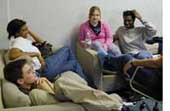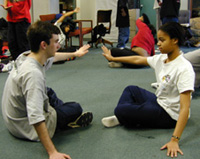WASHINGTON, DC—After three months of baring their souls and sharing their secrets with
peers they once would never have dared approach, the three dozen teenagers in the City at
Peace rehearsal room are ready to take their stories to the stage.
Since first coming to this unusual program—aimed at bringing together Washington’s
youth of all races through the performing arts—Prentice, 16, has gathered the courage to tell
of his childhood molestation and his confusion over his sexual identity. “I always grew
up thinking white kids can’t understand what we go through,” he says.
Anais, 18, has “changed everything— the way I think, the way I act, the way I
talk and walk,” she says. When she arrived here at 14, “I had a lot of attitude.
I was the Queen of South-East.” Now she serves on the City at Peace governing board,
and spends several days a week on the production team for the yearly show.
And Miriam, 18, has realized how superficial is the diversity at her suburban high school as
kids of different races segregate themselves at lunch and in hallway conversations. Real
cross-cultural understanding only happens, she says, when people “get to know each other from the ground up.”
That kind of learning takes place regularly in this rundown second-floor room in a public
school building in a largely African-American Washington neighborhood. Launched a decade
ago to promote conflict resolution and mutual understanding among young people across racial
divides, City at Peace has grown into a remarkable effort whose work extends across the city and even the nation.
 Today, some 30 Washington-area teenagers of all ethnicities and backgrounds crowd in for
their six-hour Saturday session, jostling and playing and hugging and sharing news of
school fashion shows and college acceptances.
Today, some 30 Washington-area teenagers of all ethnicities and backgrounds crowd in for
their six-hour Saturday session, jostling and playing and hugging and sharing news of
school fashion shows and college acceptances.
Since September, City at Peace mentors Sandra Holloway and e’Marcus Harper
have put them through a demanding training in theatre, music and dance that promises to change
them from the inside out. By April, the work will culminate in a full-length musical based on
their own lives, written and performed by the students themselves.
Letting Down the Pose
This day, like every other, they start with dance warm-ups and then move on to acting exercises
aimed at breaking down the poses, the fears, and the self-protective barriers that separate young
people whose stories and struggles are as various as their looks. “Everything serves several
purposes,” notes Holloway, who has been the City at Peace artistic director since 1996.
“It’s teambuilding, it’s cross-cultural understanding, it’s
relationship-building, it’s dance, music, and acting.”
Her low voice warm but authoritative, she keeps the group intent and focused as they follow
walking-about routines that have them making contact, then avoiding each other’s eyes.
“There’s something emotional that displays itself physically when you try to avoid
someone,” she coaches them. “Let that sit with you physically and emotionally.
You can’t avoid someone if you don’t see them.”
 In a “mirror” exercise, two students face each other and lock eyes, with one following
every physical movement the other makes. “When you’re not posing, when you’re
centering yourself,” Miriam says, “you can’t help letting people see who you really
are. Before you know it, you’re saying ‘I know them.’”
In a “mirror” exercise, two students face each other and lock eyes, with one following
every physical movement the other makes. “When you’re not posing, when you’re
centering yourself,” Miriam says, “you can’t help letting people see who you really
are. Before you know it, you’re saying ‘I know them.’”
Prentice describes another exercise called “speak-out,” in which “white and
black kids make two facing lines, and then we tell each other what we need to hear, what we never
want to hear, what they need to hear.” One thing he never wants to hear, he says, is “
that a white kid acts differently around me to fit into my world.”
On lunch break, the students sprawl on the floor eating the sandwiches and fruit a parent volunteer
has brought in. They dance to CDs; they pick out chords on someone’s guitar; they rest their
heads on each other’s shoulders. And they talk about how the training has changed them.
In her previous life, “everyone just accepted the image I put out of always being on top,
” recalls Anais. “Here they accepted me. Here I had to work from the inside out. I
could just speak—not use slang. I changed the way I walk. Now I can be the insecure shy person I am
and know that’s OK.” She pauses. “It’s a scary place to be,
on the brink of opening up and wondering if you’ll be accepted.”
“Even in my school of rich white kids I don’t feel so accepted,” says Alexandra,
16, who lives in a Virginia suburb and goes to an exclusive private school in the District of Columbia.
“I thought people wouldn’t talk to me here, but that’s not at all true. Here
everyone’s together and real. It’s kind of an escape--but yet the whole world is here.”
City at Peace training, Prentice agrees, has made him “freer, more accepting, open to more things
in how I deal with people.” At home with his four younger siblings and also at school, “I’m
taking the skills I’m learning and applying them. It’s tremendously changed me.”
Playing Someone’s Life, Telling the Truth
In the last hour of the day the group gathers in a circle on the floor, the room vibrating with the silence
of three dozen breaths held. Just back from an intensive planning retreat, the production team of experienced
students and professionals is about to present the outline of the upcoming show and cast each role.
In the next weeks, the students will flesh it out themselves—writing their lines, developing the dances
and music, heading for the climax of their April performance.
“This outline represents your journey together—what happened here in this room, what you talked
about, what happened as a result of that talking,” Sandra Holloway tells them. She lays out the play,
scene by scene. The kids on the floor exchange looks and smiles, touch hands. In the bones of the drama
and its fictional characters they are recognizing their own struggles and traumas, the conflicts and
decisions they have shared here with each other.
 “Now we have to trust the things you’ve said in this room,” Holloway goes on.
“You are writing this show. If you’re playing someone’s life, are you going to tell
the truth about it? Or are you going to fake it because you feel weird? Can we be honest enough to
tell each other’s stories? If there’s one person out there who will see you on stage and
say, ‘That’s me!’—and you provide hope or a solution—that’s your reward.
You guys have the opportunity to change lives.”
“Now we have to trust the things you’ve said in this room,” Holloway goes on.
“You are writing this show. If you’re playing someone’s life, are you going to tell
the truth about it? Or are you going to fake it because you feel weird? Can we be honest enough to
tell each other’s stories? If there’s one person out there who will see you on stage and
say, ‘That’s me!’—and you provide hope or a solution—that’s your reward.
You guys have the opportunity to change lives.”
A shiver goes around this circle of young people, who suddenly seem like an ensemble that will
do anything it takes to make that happen. “The more secure I get in what my goals are, the
more I’ll know what to do next,” Anais has said earlier, reflecting on whether to go to
college after she graduates from high school. “If I don’t feel passionate about something
I don’t want to do it. I want to love it, be consumed by it, teach it, grow from it.”
“In every scene, you will be asking yourself, ‘What has to happen? What has been
learned? Who learns?’” their coach concludes. “All you have from this point
on is each other. Now’s your time to fly.”
Read more about City at Peace
Read more about youth and conflict resolution in the WKCD feature story, “Making Peace, Restoring Justice”
Introduction
About Harlem Youth Court
About Peacemaking Rituals